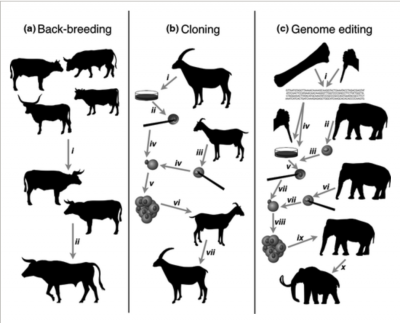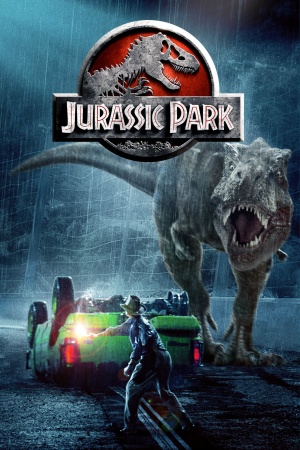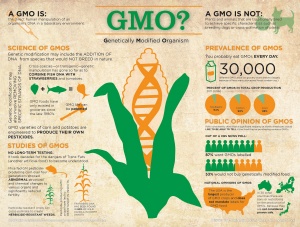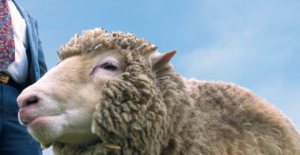Jurassic Park (1993)
As the first installment of the franchise, Jurassic Park introduces a fictional dinosaur theme park. A series of events frees the dinosaurs from their enclosures, forcing those on the island into an unexpected fight for survival. The film touches on popular ethical concerns of today, including cloning and DNA privatization and monetization.
Contents
Plot
The film begins with the death of a park employee at the hands of a Velociraptor kept at Jurassic Park. The theme park is on a fictional island called Isla Nublar, located 120 miles west of Costa Rica. The island is a peaceful, isolated preserve. Upon hearing news of the death, investors push the park's company, International Genetic Technologies, Inc. (InGen), to prove its safety. To address such concerns, the CEO of the company, John Hammond (Richard Attenborough), brings in a group of experts to hopefully gain their approval. The group includes paleontologist Dr. Alan Grant (Sam Neil), paleobotanist Dr. Ellie Sattler (Laura Dern), mathematician Ian Malcolm (Jeff Goldblum), and the investors' lawyer Donald Gennaro (Martin Ferrero). Unbeknownst to all of them, Dennis Nedry (Wayne Knight), the disgruntled lead computer programmer of the park, is bribed by rival company Biosyn to steal dinosaur embryos from Jurassic Park. These embryos would allow Biosyn to create dinosaurs like those in Jurassic Park.
Upon reaching the island via helicopter, Hammond's group of experts are quickly taken to the visitor center, where they learn the process of dinosaur creation/cloning. After a lunch break, the group, which now includes Hammond's grandchildren, is given a tour of the park in driverless electric vehicles. During the tour, a tropical storm hits the island. Using the storm as a distraction, Nedry, with plans of stealing the embryos, introduces a computer virus and deactivates the park's security system in the process. Most of the park's dinosaurs, including a Tyrannosaurus rex, go free. The Tyrannosaurus immediately attacks those still touring in the electric vehicles, separating the group and killing Donald. Nedry, who manages to smuggle dinosaur embryos into a canister, crashes his Jeep and is ultimately killed by a Dilophosaurus. Unable to bypass Nedry's computer virus, chief engineer Ray Arnold decides to perform a system reboot, which requires him to go to a utility shed across the park. When he doesn't return, they discover that the raptors have been set free. Thanks to the individual heroics of those remaining on the island, the power is ultimately fully restored. This victory is short-lived, as the raptors manage to corner the survivors in the visitor center. However, with unexpected help from the escaped Tyrannosaurus (who kills the raptors), the group finally escapes the island via helicopter.
Dinosaur Creation/Cloning
The cloning of dinosaurs is achieved in the film by extracting DNA from the blood of mosquitoes that have been preserved in amber. This has been found to be implausible to impossible in reality because of how quickly dinosaur DNA degrades in quality.[2] Nonetheless, the DNA fragments were reassembled by scientists at Jurassic Park. As the fragments were incomplete, DNA from frogs was used to fill the remaining gaps. To prevent breeding, scientists claim to have genetically engineered the dinosaurs to be only female. However, this is proven to be incorrect later on in the film, as hatched eggs are spotted at the park by Alan. A lack of sufficient knowledge on cloning and genetics by the scientists is exposed, as it is revealed that the DNA of frogs allowed the dinosaurs to change their sex in a single-sex environment.
Real Life De-Extinction
Scientists are working on techniques to bring extinct species back from the dead, known as de-extinction. The goal of this process is to ultimately create populations of healthy animals that can contribute positively to the environment.[3] With modern climate change causing species to go extinct at a rapid pace, de-extinction and other scientific processes like gene editing can help restore ecosystems.
Progress
In 2003, European scientists were able to revive the Pyrenean ibex which had gone extinct a few years earlier. The animal only survived a few minutes.[3] Another team in Australia is working to bring back the gastric-brooding frog. They have succeeded in producing embryos but not in turning these embryos into tadpoles or frogs.[3]

Methods
In 2016, the International Union for Conservation of Nature (IUCN) established guidelines for the de-extinction process. These guidelines outlined three methods of de-extinction: selective breeding, genome editing, and cloning. [4]
Selective Breeding
Selective breeding aims to resurrect the ancestral phenotypes of an extinct species by back-breeding from modern closely related species.[5] This process can take a long time depending on the generation length of the organism. The end result will be an animal with similar traits to the extinct species, but not necessarily the same genes.[5]
Cloning
Cloning creates genetically identical copies of a species by combining DNA from preserved cells with egg cells from a closely related species.[5] This is difficult to do with long-extinct species because there are not often intact preserved cells.
Gene Editing
Genetic engineering of extinct species is achieved by editing the genome sequence of closely related living species until it closely resembles that of an extinct species. An example of this is the Harvard Woolly Mammoth Revival team headed by geneticist George Church, which is aiming to bring back the wooly mammoth by editing mammoth genes into Asian elephant cells. [6]
Tree Resin Amber DNA Extraction
As seen in the film, the scientists use amber fossils to extract their jurassic DNA. Teams of scientists from the University of Manchester have completed thorough research into the possibility that humans can extract DNA from amber-encrusted insects, and discovered that this method does not work. [7] The teams also tested DNA extraction from copal, which is a mid-stage tree resin fossil that would eventually become amber. Neither the copal nor amber samples provided DNA that would be able to clone living dinosaurs in the 21st century. [8]
GMOs
Another more well-known example of DNA modification in our modern world are GMOs. GMO stands for genetically modified organism. This includes plants, animals, and bacteria. To create a GMO, scientists insert a small piece of DNA into the nucleus of a cell that is to be modified. [9] DNA existing in the nucleus is already very compact. A single corn cell has enough DNA stored in the nucleus to stretch around 6 feet from end to end. Because of this, most of the organism is still the same with the exception of a small piece of inserted DNA. The organism is then sustained and treated with natural hormones to stimulate growth until the cells begin to divide and take on specialized roles of the organism. Since this plant came from one cell, all of the new cells are replicas of the originally modified cell. It is now a GMO. There are already many types of GMOs that have been created. Corn, soy, canola, and many other plants that have been genetically modified and used as ingredients for packaged goods. [10] These GMOs have a greater crop yield, reduced need for pesticides, enhanced nutrition, and resistance to pests and environmental stresses. This allows plants to grow in harsher environmental conditions. There are still many more GMOs currently being developed. Rice that will have more Vitamin A, oral vaccines, and regular vaccines as well. [11]Ethical Concerns
Irreversible Science
Elizabeth Rayne points out that the entire movie serves as a good metaphor for irreversible science. Any exploratory new experiments that can have irreversible damage ought to be analyzed in depth before their implementation she argues.[12] These can apply to fields beyond genetics such as nuclear physics or weapons research. This is well summarized in the line by Jeff Goldblum’s character, Ian Malcolm, “Yeah, but your scientists were so preoccupied with whether or not they could, they didn't stop to think if they should”.[13]
Cloning
Perhaps the main ethical debate of the film is the use of cloning by scientists. Whether cloning is ethically right to practice has been a hot topic of debate. Data from polling has revealed that the public is heavily against the use of cloning on animals. [14] Broadly speaking, concerns can be categorized into two main groups: negative consequences on animals, humans, and the environment, as well as the violation of moral principles and guidelines.[15] For the first group, one argument being made is that cloning intentionally and unintentionally tampers with the environment, disrupting the fragile balances of ecosystems. [16] Additionally, restoring extinct species through cloning can have significant economic and ecological problems, much of which is unpredictable.[17] With a connection to the film, the revival of extinct dinosaurs in Jurassic Park ushered in events the scientists never expected, while completely altering the island of Isla Nublar. In regards to the second group of concerns, some objections against cloning are "intrinsic," or view the activity as simply wrong and unjustifiable regardless of the outcome.[18] Proponents of such concerns argue that is morally incorrect to "play God" and that creating life should always be a natural process. [19]
Dolly the Sheep
During the 90s, when the film was released, Dolly the Sheep became a popular real success story in the cloning of mammals. Dolly was produced by researchers at the Roslin Institute in Scotland through somatic cell nuclear transfer from a different animal. The embryo was then implanted into a different sheep and successfully cloned Dolly the sheep. Her case is proof that humans possess the ability to clone living mammals. Dolly’s existence was groundbreaking and controversial. The public argued about the ethical implications of cloning mammals, and whether people should be able to clone human beings. Since the '90’s, several other mammals have been successfully cloned, but humans have not been. [20]
Although the major controversy from Dolly revolved around the potential of “playing God” when it comes to creating humans, Dolly’s research team never intended to apply this discovery to human creation. Instead, they have used somatic cell nuclear transfer to advance medicine by generating human stem cells to treat diseases, known as therapeutic DNA transfer. [21]
Reproductive Cloning
Human reproductive cloning- the practice of cloning a human being- is illegal in most countries and has never been accomplished before. [22] The major arguments for the ethical concerns of human reproductive cloning focus on the notion that a child made from cloned DNA would lose their autonomy since their personality and physiological traits are already known. There is a violation of the right to ignorance of that being’s future. NCBI states that reproductive cloning infringes on the individuality of the individual and treats humans as customizable objects. [23]
Therapeutic Cloning
While reproductive cloning aims to create a living being, therapeutic cloning is practiced to eventually terminating the embryo. This involves producing a human embryo, extracting its stem cells, and then destroying the embryo. Therapeutic cloning is utilized to save lives, but this justification is still controversial. [24]
Privatization and Monetization of DNA
The film, Jurassic Park is created with the hope that it one day would be a huge moneymaker. To do so, the company owning the park purchased much of the world's amber mines in search of viable DNA to use for cloning. This brings up another ethical concern: the privatization and monetization of DNA. Particularly, regulations are much more lenient for private companies dealing with genetic data banks than for federally funded researchers.[25] As private companies are the "ultimate gatekeepers for their data," concerns have been raised about whether what they're doing with it is ethically correct.[26] With regards to the monetization of DNA, concerns deal with whether it is ethically okay to exploit genetic data for monetary gain. Proponents against DNA monetization highlight consent concerns, as well as potential breaches of privacy.[27] This is a concern in regards to real genetic companies today like 23andMe that have human genetic data. Such concerns are only exacerbated by incidents in which savvy hackers were able to steal genetic data, as well as by insufficient law coverage of genetic privacy.[28] Such company breaches of sensitive information not only come from outside attackers but as seen in Jurassic Park, can occur internally as well.
GMOs
GMOs are a very hotly debated topic. There are many reasons why GMOs are good and also many reasons why they are bad. This has led to the debate of whether or not GMOs should be allowed. A very good example of this is the golden rice debate. Golden rice was a project to modify rice in order to produce more nutrients that would benefit those in developing countries that had a lack of specific nutrients. Those that opposed the idea of bioengineering this new rice voiced their concerns of the possible negative consequences of antibiotic resistant “super bugs” and harming the biodiversity with the accidental introduction of the GMO into the environment. Poorer farmers also would not be able to compete against large bio-companies for share of land and market. However, there are of course benefits to GMOs. In the case of golden rice, people in developing countries would be getting more beta-carotene which is used by the body to produce more vitamin A. Deficiencies in vitamin A cause many deaths in developing countries. UNICEF has been able to increase a child’s survival rate by 12% to 24% with vitamin A supplements alone. Both sides have valid reasons supporting their ideas but there is no ethical way to determine what the best course of action is. [29]
References
- ↑ Jurassic Park Franchise Box Office History. (n.d.). Retrieved March 11, 2021, from http://www.the-numbers.com/movies/franchise/Jurassic-Park#tab=summary.
- ↑ Knapp, A. (2013, September 14). Scientists Show That Jurassic Park-Style Dinosaur Cloning Couldn't Happen. Retrieved March 12, 2021, from https://www.forbes.com/sites/alexknapp/2013/09/14/scientists-demonstrate-that-jurassic-park-couldnt-happen/?sh=14030acc2f7e.
- ↑ 3.0 3.1 3.2 Pilcher, Helen. “De-Extinction: Can We Bring Extinct Animals Back from the Dead?” BBC Science Focus Magazine, 12 July 2020, www.sciencefocus.com/nature/de-extinction-can-we-bring-extinct-animals-back-from-the-dead/.
- ↑ Novak, Ben Jacob. “De-Extinction.” Genes vol. 9,11 548. 13 Nov. 2018, doi:10.3390/genes9110548
- ↑ 5.0 5.1 5.2 Shapiro, Beth. “Pathways to De‐Extinction: How Close Can We Get to Resurrection of an Extinct Species?” Functional Ecology, vol. 31, no. 5, 2016, pp. 996–1002., doi:10.1111/1365-2435.12705.
- ↑ “WOOLLY MAMMOTH REVIVAL.” Revive & Restore, reviverestore.org/projects/woolly-mammoth/.
- ↑ Knapp, A. (2013, September 14). Scientists show that jurassic park-style dinosaur cloning couldn't happen. Retrieved April 12, 2021, from https://www.forbes.com/sites/alexknapp/2013/09/14/scientists-demonstrate-that-jurassic-park-couldnt-happen/
- ↑ Miller, A., Johnson, J., Makhortykh, S., Gerling, C., Litvinova, L., Andrukh, S., . . . Roberts, P. (n.d.). Re-evaluating Scythian LIFEWAYS: Isotopic analysis of diet and mobility in Iron Age Ukraine. Retrieved April 12, 2021, from https://journals.plos.org/plosone/article?id=10.1371%2Fjournal.pone.0245996
- ↑ What Are GMOs?, ag.purdue.edu/GMOs/Pages/WhatareGMOs.aspx.
- ↑ “GMO Facts.” Non, www.nongmoproject.org/gmo-facts/.
- ↑ Nature News, Nature Publishing Group, www.nature.com/scitable/topicpage/genetically-modified-organisms-gmos-transgenic-crops-and-732/.
- ↑ Rayne, Elizabeth. “Wednesday Rewatch: Digging up the Morality of Jurassic Park 25 Years Later.” SYFY WIRE, SYFY WIRE, 12 June 2018, www.syfy.com/syfywire/wednesday-rewatch-digging-up-the-morality-of-jurassic-park-25-years-later.
- ↑ “Jurassic Park1993.” Dr. Ian Malcolm: Yeah, but Your Scientists Were so Preoccupied with Whether or Not They Could, They Didn't Stop to Think If They Should., www.quotes.net/mquote/49960.
- ↑ Fiester, A. (2005). Ethical Issues in Animal Cloning. Retrieved March 12, 2021, from https://repository.upenn.edu/bioethics_papers/35
- ↑ Fiester, A. (2005). Ethical Issues in Animal Cloning. Retrieved March 12, 2021, from https://repository.upenn.edu/bioethics_papers/35
- ↑ Fiester, A. (2005). Ethical Issues in Animal Cloning. Retrieved March 12, 2021, from https://repository.upenn.edu/bioethics_papers/35
- ↑ L. (2016, February 19). De-Extinction, a risky ecological experiment. Retrieved March 12, 2021, from https://www.esa.org/esablog/2016/02/19/de-extinction-a-risky-ecological-experiment/
- ↑ Comstock, G. (2012, February). Ethics and Genetically Modified Foods. Retrieved March 12, 2021, from https://www.researchgate.net/publication/297320628_Ethics_and_Genetically_Modified_Foods
- ↑ Fiester, A. (2005). Ethical Issues in Animal Cloning. Retrieved March 12, 2021, from https://repository.upenn.edu/bioethics_papers/35
- ↑ Share 6 September 2017, 2017, 6., 2021, 1., 2021, 2., & 2021, 4. (2018, January 26). Dolly the sheep's scientific and Ethical legacy. Retrieved April 12, 2021, from https://www.rathbones.com/knowledge-and-insight/woolly-thinking-dolly-sheeps-scientific-and-ethical-legacy
- ↑ Share 6 September 2017, 2017, 6., 2021, 1., 2021, 2., & 2021, 4. (2018, January 26). Dolly the sheep's scientific and Ethical legacy. Retrieved April 12, 2021, from https://www.rathbones.com/knowledge-and-insight/woolly-thinking-dolly-sheeps-scientific-and-ethical-legacy
- ↑ Home - pmc - ncbi. (n.d.). Retrieved April 12, 2021, from https://www.ncbi.nlm.nih.gov/pmc/
- ↑ Home - pmc - ncbi. (n.d.). Retrieved April 12, 2021, from https://www.ncbi.nlm.nih.gov/pmc/
- ↑ Home - pmc - ncbi. (n.d.). Retrieved April 12, 2021, from https://www.ncbi.nlm.nih.gov/pmc/
- ↑ Spector-Bagdady, K. (2016, September 13). Why You Should Worry About the Privatization of Genetic Data: SciTech Connect. Retrieved March 12, 2021, from http://scitechconnect.elsevier.com/worry-privatization-genetic-data/
- ↑ Spector-Bagdady, K. (2016, September 13). Why You Should Worry About the Privatization of Genetic Data: SciTech Connect. Retrieved March 12, 2021, from http://scitechconnect.elsevier.com/worry-privatization-genetic-data/
- ↑ Ahmed E., Shabani M. (2019). DNA data marketplace: an analysis of the ethical concerns regarding the participation of the individuals. Front Genet. 10:1107. 10.3389/fgene.2019.01107. https://www.ncbi.nlm.nih.gov/pmc/articles/PMC6844291/
- ↑ Rosenbaum, E. (2018, June 16). 5 biggest risks of sharing your DNA with consumer genetic-testing companies. Retrieved March 12, 2021, from https://www.cnbc.com/2018/06/16/5-biggest-risks-of-sharing-dna-with-consumer-genetic-testing-companies.html
- ↑ “Genetically Modified Organisms: The Golden Rice Debate.” NYU Langone Health, med.nyu.edu/departments-institutes/population-health/divisions-sections-centers/medical-ethics/education/high-school-bioethics-project/learning-scenarios/gmos-the-golden-rice-debate.


